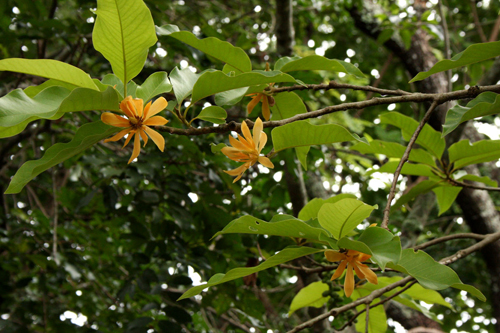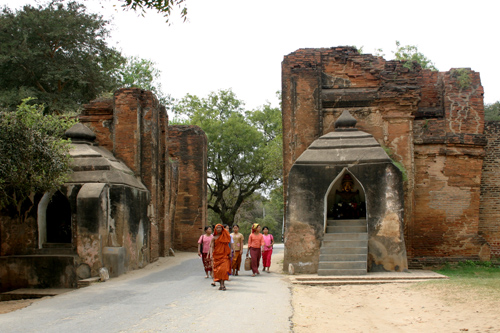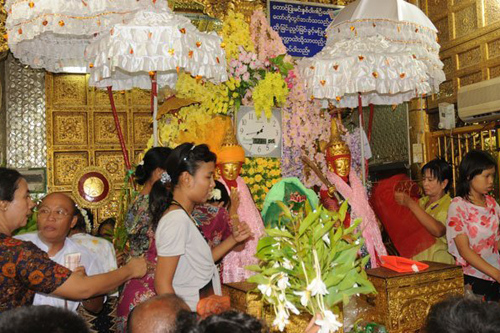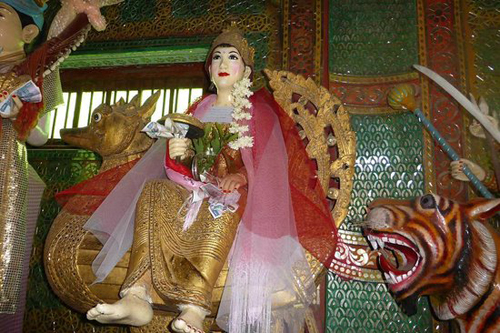Before King Anawrahta came to the throne, Bagan already has both Theravada and Mahayana sects of Buddhism, as well as Spirit worship.
In 1044, seven hundred years before Anawrahta came to the throne there was a Pyu kingdom of Tagaung on the banks of the upper reaches of the Ayeyarwaddy River. The Pyu king was feeling uneasy: a handsome young blacksmith was becoming too popular among his citizens. He feared the young man's strength, for it was said that land and mountains trembled with each blow of his hammer.
This man named Maung Tint Dei, Mr Handsome was much admired for his looks and kindness, and for the tender care of his family. The king went out to see him for himself but fell in love with the blacksmith's younger sister and made her queen.
Still, he worried that the blacksmith would overthrow him. He asked his new queen to invite her brother to court and as soon as the young man arrived, guards took him and chained him to a Champac tree. He was to be burnt alive and his sister, on hearing the news, ran to the pyre and jump into the flames. The king grabbed at her hair but could only save her head. Brother and sister perished and their spirits haunted Champac the tree.

The king had the tree chopped down and thrown into the Ayeyarwaddy River, where it floated until it reached Bagan. The spirits spoke through astrologers to King Thelai Kyaung, 7th in the Bagan Dynasty, to ask for refuge. The king had their images carved out of the Champac log and set up their shrine at the foot of the cylindrical Popa Crest next to the extinct volcano Mt Popa. In Bagan, their images can be seen on either side of Tharaba Gate while over the years new shrines were built on the original site.
The two became the guardian spirits of city, family, and home. The brother became known as Min Maha Giri or Lord of the Great Mountain and his sister as Shwe Myet Hnar, the Lady Golden Face, the only part of her that was saved.
Their other family members were Maung Tint Dei's wife, their sons, another sister, and a niece who all died tragically to join him in the spirit realm His wife Shwe N'bay or the Lady Golden Sides is a half-dragon half-human descended from the deities of snake worship of Tagaung's Pyu era. In the form of a dragon she had flanks of gold and as a human her dress had golden sides. The other sister was Thon Pan Hla, the Lady Three Times Beautiful for it is said she grew in beauty through the morning, afternoon and night. She became the patroness of beautiful women while her three-year-old daughter Ma Hne Lay, the Little Lady Oboe, became the protector of children.

Another spirit family is directly connected to Bagan. When Anawrahta invaded Thaton and brought back King Manuha and family in golden chains, the king's younger sister Wunna Theingi, the Lady Purest Gold, escaped into the forests surrounding Mt Popa. There, through meditation, she changed her appearance to look like an ogress so that she might be safe from men and beasts.
Byatta, a knight of Anawrahta, was one of the two Arab brothers shipwrecked and stranded in Thaton. After his brother, Byatwi was killed by King Manuha and he fled to serve Anawrahta. It was only when his dead brother's spirit helped them that the invading Bagan armies could enter the well-fortified Mon city. Byatta met Wunna Theingi while he was gathering flowers for the king. Wunna Theingi and Byatta fell in love and they had two sons. However, she never came to the court of Anawrahta who had conquered her kingdom. It is said that one-day Byatta failed to return to court in time and that he was executed as punishment.
Anawrahta then took pity on their sons and took them to court to raise as his own, naming them Min Gyi and Min Lay, the Elder and Younger Prince. They grew up arrogant and wild, spending their time with toddy wine and women.
On one military campaign to the north, they failed to attend to the king's wish to bring one brick each to a pagoda being built at Taungpyone Village, a few miles near present-day Mandalay. For this infringement, they were executed by the jealous ministers. When the king's barge was about to return to Bagan, the spirits of the two brothers would not let it go. They spoke through mediums and asked the king to grant them a shrine, which the king did in Taungpyone Village. At their annual festival here in September, descendants of the men Anawrahta left in charge must return to officiate even though they may be in other professions.

The Taungpyone festival is the biggest spirit ceremony in the country and the two brothers are the most powerful spirits. If they are pleased by the offerings of food, dance, and music they grant good fortune and if crossed, would cause much harm.
Their mother on hearing of their deaths had run to Taungpyone but died of exhaustion in present-day Amarapura, a suburb of Mandalay She became the Mother Goddess of Popa, guardian spirit of women and families. A week after her son's festival, hers is held in Amarapura, where she died. Byatta and Byatwi also became spirits but they are not as powerful as the Popa Goddess or the Taungpyone Brothers. As Byatta was an Arab, the Popa family of spirits does not eat pork nor do their devotees.
Two spirits who are not of the Popa family but their deaths caused by one Taungpyone brother is the patron of weavers Ma Shwe Oo and her husband Ko Yin Maung, patron of foresters. The Spirit Min Lay fell in love with Ma Shwe Oo and courted her but she spurned him.

Angry at her rebuff he sent his riding spirit tiger to kill her. Ko Yin Maung died of a broken heart and both became spirits. As they are still bitter towards the Popa family, their images are never placed near the two brothers.
There are other spirits whose old images can also be seen in a pavilion at the Shwezigon Pagoda but their stories are not connected to the myths that surround Bagan.
